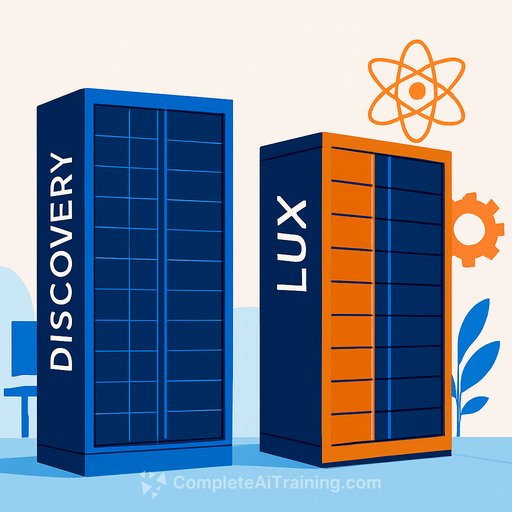DOE's Discovery and Lux: New AI Supercomputers at ORNL
The U.S. Department of Energy announced two new systems at Oak Ridge National Laboratory: Discovery and Lux. Together, they push U.S. leadership in AI-driven science, high-performance computing, and national security work. Researchers get more scale, more memory bandwidth, and a clearer path to AI-first scientific workflows.
- Discovery and Lux were announced at ORNL to advance AI and high-performance computing.
- Both systems support AI-driven research in energy, manufacturing, medicine, and cybersecurity.
- Lux arrives in 2026; Discovery is slated for delivery in 2028.
Why this matters to research programs
AI-centric science needs three things: massive compute, high-throughput storage, and tight integration with simulation and data pipelines. Discovery and Lux bring all three. Expect shorter training cycles, faster validation loops, and more ambitious multi-physics and multi-modal experiments.
Discovery: the next step beyond Frontier
Discovery, arriving in 2028, is built on the HPE Cray Supercomputing GX5000. It uses upcoming AMD EPYC processors (codenamed "Venice") and AMD Instinct MI430X GPUs, plus a DAOS-based HPE Cray Supercomputing Storage Systems K3000-the first factory-built storage system with embedded open-source software. The system is designed to exceed Frontier across the stack.
For researchers, that means bigger models, larger ensembles, and tighter coupling between simulation and learning. Practical wins on day one include:
- AI modeling to make nuclear energy safer, cheaper, and more available.
- AI-driven digital twins for precision medicine and patient outcomes.
- Aerospace design cycles shrinking from years to months for more efficient aircraft.
Discovery will continue ORNL's path to the convergence of HPC, AI, and quantum. It's built to move from training to inference to uncertainty quantification without re-architecting your whole workflow.
Lux: near-term AI capacity for national priorities
Lux, deploying in 2026, boosts near-term AI capacity and targets fusion, fission, materials, quantum, advanced manufacturing, and the grid. It ties together deep domain expertise across the DOE lab network with curated datasets for science at scale.
Under the hood, Lux employs AMD Instinct MI355X GPUs, AMD EPYC CPUs, AMD Pensando advanced networking, and HPE ProLiant Compute XD685. The AMD-led system also leverages Oracle Cloud Infrastructure as part of the Lux AI Cluster, enabling large-scale training and distributed inference with a secure, open software stack.
Public-private momentum
"National Labs are perfectly suited to support this unique public-private partnership… because of our ability to deploy hardware and software at scale for these missions," said ORNL Director Stephen Streiffer. AMD's Lisa Su noted Discovery as the next major leap after Frontier and El Capitan, while HPE's Antonio Neri emphasized new levels of scientific productivity and complex simulations ahead.
How to prepare your team
- Pipeline design: Plan for mixed workloads (simulation + foundation models + retrieval). Assume distributed training and multi-node inference.
- Data readiness: Adopt FAIR practices and DAOS-friendly layouts. Prioritize high-quality labels, provenance, and versioning.
- Model strategy: Build transfer and fine-tuning paths for domain-specific tasks; include UQ and interpretability from the start.
- Security & compliance: Map requirements early for sensitive projects in energy, health, and national security.
- Access planning: Watch for calls via the Oak Ridge Leadership Computing Facility and DOE Office of Science user programs.
For program and user facility updates, see the DOE Office of Science at energy.gov/science and the Oak Ridge Leadership Computing Facility at olcf.ornl.gov.
Timeline
- Lux AI Cluster deployment at ORNL: 2026
- Discovery system delivery: 2028
Bottom line: if your research depends on large, data-hungry models-or tight loops between simulation and AI-start lining up datasets, workflows, and proposals now. The queue will move fast, and the science will, too.
Your membership also unlocks:






